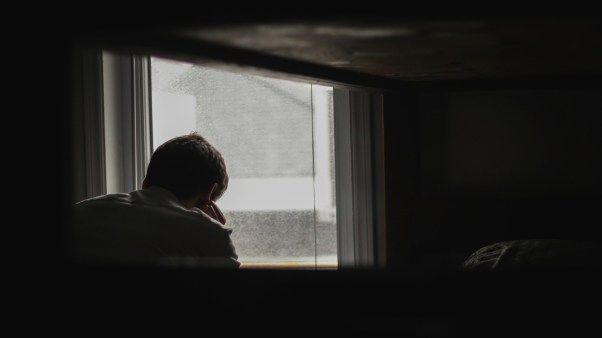Every day, it seems, there’s a new book about technology, and most of them are boring or bad.
Christian authors are unfortunately among the chief culprits, rehearsing the same truisms—God is the source of all creativity; God made us to be makers; any tool can be bent toward sin or gospel service; what we need are wisdom and virtue and good habits—without saying anything new or particularly interesting. Worst of all, tech authors tend to pull their punches. As Antón Barba-Kay notes, “After a few hundred pages of incisive criticism, such authors feel compelled to conclude on a note of contrived and desperate positivity.” It can’t be that bad, they seem to want to say. If it were, we’d be in real trouble.
I am here to tell you that Clare Morell’s new book, The Tech Exit: A Practical Guide to Freeing Kids and Teens from Smartphones, is the exception to this rule. Morell does not lack the courage of her convictions. She does not shy away from the problem. She does not flinch at the crisis faced by families, schools, and churches today. Her writing packs a punch.
Because I write and teach on this topic, I’m regularly asked to recommend books to students, pastors, and friends. These are not scholars looking for theory but ordinary folks looking for help. Andy Crouch’s The Tech-Wise Family, published in 2017, has always been the first work I mention. Since then, I’ve added Cal Newport’s Digital Minimalism(2019) and Jonathan Haidt’s The Anxious Generation (2024) to the list. And now, with The Tech Exit, I can finally fill out my personal Mount Rushmore. That’s how good it is.
Morell is a fellow at the Ethics and Public Policy Center and director of its Technology and Human Flourishing Project. She has worked on policy from within the government and reported on it from without. In addition to her Substack, called Preserving Our Humanity, in the last year alone she has coauthored essays in First Things, The New Atlantis, and National Affairs on the threat posed by digital technology to human flourishing. And although her book is not explicitly religious, Morell is a Christian; her husband is a pastor at Capitol Hill Baptist Church in Washington, DC. Much of the book’s fire comes from her experience as a mother of three young children.
From fast to FEAST
Digital devices present a clear and present danger to children’s well-being: That is the premise, not the conclusion, of The Tech Exit. The book is written to parents who already understand the problem, not to skeptics who need to be persuaded it exists. So Morell starts with the solutions currently on offer, such as screen-time limits and parental controls. At best, she argues, these aren’t working. More often, they serve to soothe parents’ consciences while making the problem worse.
From here, Morell identifies a “major disconnect” between the scale of the challenge and the scale of our responses. “Screen-time parents,” as she calls them, accept “that screen-based technologies are an inevitable part of childhood.” The most such parents can do, therefore, is “harm reduction.” The question thus becomes how much harm to my children I’m willing to tolerate.
Morell thinks this question amounts to surrender without a fight. Her fundamental contention is that “digital technologies need not be an inevitable part of childhood” and that it’s “even possible to reverse course if you’ve already given your child a smartphone or social media and now regret it.”
Part of the book’s appeal is that Morell herself lives this life and populates the chapters with examples of families she visited or interviewed for her research. She is walking the walk—in Washington, DC! Her pitch is that you, right now, wherever you find yourself, can adopt this path today.
But how? By beginning with fasting and ending with feasting. First, recognize the futility of your attempts at harm reduction. Second, fast from your family’s digital entanglements. And third, adopt the Tech Exit approach to technology, which Morell captures in the acronym FEAST. (More on what it stands for in a moment.)
Morell’s vision of tech fasting is far more robust than screen-time limits and parental controls, which are unreliable and easily circumvented by even novice teen users. (Dear reader: Trust her on this one.) Limits of this type imply that “screens are like sugar”—“a treat to be enjoyed with abandon sometimes and consumed in moderation in an otherwise-balanced diet.” But what if that’s the wrong metaphor? She proposes an alternative: “Digital technologies are not like sugar. For the developing brains of children and teens, they are more like fentanyl.”
Morell piles up study after study to support this interpretation of digital ills for children and teenagers. I won’t regurgitate her evidence here except to say that it’s utterly compelling. This is how screen-time parents are put in the “untenable, exhausting” position of “constantly having to stand between a drug-dispensing machine and an underdeveloped brain.”
Just say no
So what’s the alternative? Morell means the “exit” in her title literally. The Tech Exit approach is “no smartphones, social media, tablets, or video games during childhood”—period. (She also thinks the TV should be chucked, but if you want to pull it out of the closet for family movie nights or sleepovers with friends, so be it.)
This might strike you as appealing in theory but impossible in practice, especially if, like me, you’ve never stepped foot in a household that lacked a television or (more recently) wireless internet and smartphones. For such readers, Morell suggests a digital detox: a 30-day removal of every screened device in your home. Try it and see how life works in your household over the next month.
Based on her own experience and the testimonies of dozens of families around the country, Morell suggests the experience will begin with pain. The children will complain. Boredom will menace. Your fingers will get twitchy.
At some point, though, you’ll notice the kids playing outside, unprompted. You’ll realize you haven’t had to broker a screen-time truce between warring siblings for days. You’ll feel a calm you’ve not felt in a while and realize the screen-time life was never actually inevitable.
Because fasting comes to an end, the heart of the book is about maintaining a digital-free household. This is where the acronym FEAST comes in. F stands for “Find Other Families,” because you can’t do this alone. E is for “Explain, Educate, and Exemplify,” because you need to be informed enough to teach and model for your children why you’re living this way. A is “Adopt Alternatives,” because you’ll need to navigate school, driving, and friendships without digital intermediaries. S is “Set Up Digital Accountability and Family Screen Rules,” because kids need clear expectations, especially if you do allow some screens in the home. Last, T stands for “Trade Screens for Real-Life Responsibilities and Pursuits,” because your household needs rich forms of leisure and service to fill the time you aren’t spending on screens.
Throughout the chapters unpacking these principles, Morell answers all the questions you’d expect: Will we be the weird ones? Will my kid miss out? Will he be picked on? Will she lose friends? What about GPS? What about safety? What about homework? Her answers are satisfying because they’re grounded in actual families’ experiences, because they’re far more easily mustered than we tend to think, and because Morell’s proposal is not actually that radical.
The proposal of The Tech Exit is not that we return to the 1800s or even the 1950s. Morell is asking us to go back to 2005—no iPad, no iPhone, no social media—or at most 1985, right before the first Nintendo console was released in the United States. In other words, Morell is not indulging in agrarian nostalgia. She’s not a reactionary. She wants you to live where you are, when you are, in a home that looks and feels like 2025 in every way—minus digital surfaces. These, for your sake and the sake of your children, you should expel from the home at once. Consider it an act of technological exorcism.
Schools, politics, and church
Most tech books end here, with the local and the personal, but Morell’s last two chapters are about public schools and public policy. She praises the encouraging development of schools across the country (in both red and blue states) adopting bell-to-bell, no-screen, zero-tolerance policies.
My own school district just approved such a plan, and I see it as the definition of a common-sense policy. But why stop at K–12? Why not extend it to college? That’s the way I run my classroom. What if the whole campus were screen-free?
Then there’s the question of what may be done through state and federal law. Morell wants Congress to protect children from Silicon Valley’s designs, arguing that we need a MADD—Mothers Against Drunk Driving—for the digital age. She shares parents’ stories to show how ordinary parents (especially mothers) are already taking the fight to Big Tech. Still, this fight cannot be won if it never moves beyond the local. Collective solutions are required, because the network effects of smartphones and social media mean they affect even those who abstain.
Here too Morell is not advocating an extreme position. We have laws protecting minors from alcohol, tobacco, drugs, gambling, and pornography, and we limit marriage, military service, tattoos, and legal contracts to people of a suitably mature age. Why not add smartphones and social media to the list? “Laws help set norms,” Morell notes, and can hold corporations liable for misbehavior.
To all this, as a reader and father of four, I reply, “Bravo! Amen! May your tribe increase!” As you can tell, there is much to celebrate and little to criticize in this book. But let me conclude with four observations.
First, I was worried Morell would hold out the Tech Exit life as all or nothing. Thankfully, she does not. She understands that some families will come to different conclusions and that some will be forced to deal with compromises and constraints. She honors families doing only what they believe they realistically can, but she does so without qualifying her claims about the superiority—and viability—of the full Tech Exit “feast.”
Second, Morell acknowledges the class component of digital habits: The tyranny of screens is hardest to bear for working single moms, divorced households, and poor families. Thus have we gone from seeing broadband access for the poor as a matter of justice to seeing affluent families opt out of digital life altogether. It’s telling that the same executives getting laptops into public schools send their own children to screen-free private schools. Even as more and more institutions and families recognize the dangers of digital devices and act accordingly, millions on the lower rungs of the socioeconomic ladder are likely to be left behind.
Third, this book was one more reminder that many churches are part of the problem. The time is long past to commit to screen-free church. Pastors have a responsibility to act. Rid the sanctuary of screens. Keep all digital devices in the foyer or the car. Quit using social media for news and updates, and for God’s sake, don’t make youth group harder for teens without smartphones. Christians should be ashamed that the church is bringing up the rear—behind public schools!—on the ills of digital technology. We could have led. Unfortunately, that time has passed. The least we can do now is catch up to everyone else.
Fourth and finally, the only misstep in the entire book is the way Morell portrays parents. Like Abigail Shrier in Bad Therapy, Morell projects onto parents the right values, the right goals, the right hopes and dreams for their children. What they lack, on her view, is merely the empowerment to do what they already know to be best.
Unfortunately, as CT editor Bonnie Kristian has noted elsewhere, parents are part of the problem too. They’re the ones who say they want “a phone-based childhood,” often under the illusion that constant connection is a guarantee of safety. They’re the ones with the devices—and they love them. Nobody’s tricking them into handing on their digital habits.
Parents must learn to see both why digital screens are harmful to children and what a genuine alternative might be, and Morell helps with this double task mightily. More than this, though, parents have to unlearn their own love of the screen-mediated life. Mom can’t be hooked to Instagram or TikTok while forbidding her daughter to open an account; Dad can’t be a gamer or sports gambler (much less addicted to porn) while warning his son away from these enticements. We parents must be well to impart health to our children, and we must possess a vision of the good toward which we are moving as we make decisions and form habits—a good that is neither self-evident nor universally recognized.
The biggest mistake a parent might make in closing this book, having been persuaded by its arguments, is to treat technology the way some churches once approached sexual purity. Like sex, digital devices would become horrible, no good, and very bad—right up until the moment they’re not. Morell is right that “if you change the laws, you can change the culture.” But laws alone won’t do the job. Lasting change has to come from above (law and policy) and from below (parents and neighborhoods), the spirit reinforcing the letter, so to speak. If change comes only from above, then we’ll be doomed to a kind of digital Prohibition: laws on the books that everyone hates and no one obeys.
“First take the plank out of your own eye,” Jesus says, and then you will see clearly to help others (Matt 7:5). Transformation begins in the heart, “and what comes out of the mouth proceeds from the heart” (15:18, ESV). In the case of technology and children, words and deeds alike begin and end with parents. Clare Morell has offered us the right tools for the change our homes so desperately need. The question is whether we will use them—first of all on ourselves.
Brad East is an associate professor of theology at Abilene Christian University. He is the author of four books, including The Church: A Guide to the People of God and Letters to a Future Saint.


























